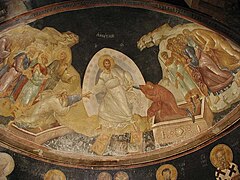Resurrection of Jesus in Christian art
In the teachings of the traditional Christian churches, the sacraments derive their saving power from the passion and resurrection of Christ, upon which the salvation of the world entirely depends.
In Byzantine and later Eastern Orthodox art this has remained the case, but in the West the depiction of the actual moment of Resurrection became common during the Gothic period.
[3] An early symbol of the resurrection was the wreathed Chi Rho, whose origin traces to the victory of Emperor Constantine I at the Battle of the Milvian Bridge in 312 AD, which he attributed to the use of a cross on the shields of his soldiers.
[7] The next stage in the development of the image was the use of the secondary event of the visit of the Three Marys (usually two in early depictions), or the Myrrhbearers as they are known in Eastern Orthodoxy, at the empty tomb of Jesus to convey the concept of the Resurrection; this was included in all four Gospels.
From the second half of the 7th century, depictions of a risen Christ walking in the garden start to appear in conjunction with the two women and the angel in Western art.
The famous Romanesque reliefs of c. 1100 in the cloister of the Abbey of Santo Domingo de Silos devote large panels to both the Doubting Thomas scene, enacted with not only all the Apostles present, but also St Paul, and the Meeting on the Road to Emmaus.
[14] In traditional Orthodox iconography the actual moment of the Resurrection of Christ ("Anabasis") is never depicted, unlike the treatment of the raising of Lazarus.
A good example is from the Chora Church in Istanbul, where John the Baptist, Solomon and other figures are also present, depicting that Christ was not alone in the resurrection.
[13] The depiction sequence at the 10th-century Hosios Loukas monastery in Greece shows Christ wearing a new tunic, with gold lines, after he has broken through the gates of Hell.
The iconography showing Christ stepping out of a sarcophagus, and placing his foot on one of the sleeping soldiers is first found in English alabaster reliefs.
Like many aspects of Resurrection imagery, it may have drawn on medieval drama, which evolved complex traditions for dramatizing the event, including laments by the women at the tomb, and sub-plots involving the soldiers.
One of the claimants to be the earliest surviving works to show this iconography is the well-known fresco by Andrea da Firenze in the Spanish Chapel of the Basilica of Santa Maria Novella in Florence, which dates to 1366.
[23] The Council of Trent (1545–1563) objected to the floating or hovering depictions, and demanded a return to the older conception, with Christ's feet firmly on the ground, either stepping out of a sarcophagus, or standing upright, holding a banner.





